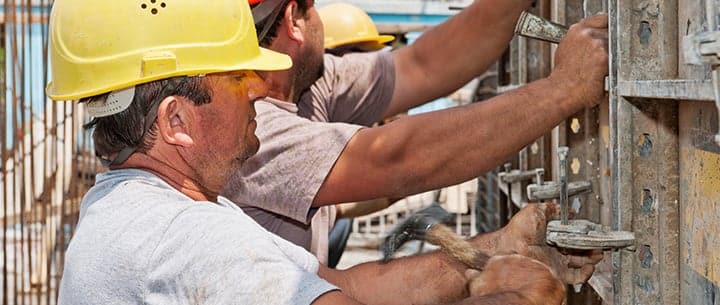Mesothelioma has long been associated with asbestos exposure in the workplace. Many companies used asbestos from the early 1900s through the 1970s or 1980s. Some of the workers at greatest risk for asbestos exposure in the past worked in construction, shipyards, mechanic shops, and factories.
If you’ve been diagnosed with mesothelioma, asbestosis, or asbestos-related lung cancer, you may be entitled to substantial compensation. Fill out our form to receive our free Financial Compensation Packet. Our packet is loaded with information on experienced mesothelioma attorneys in your area, how to file a claim for asbestos trust funds, how to get paid in 90 days, and more.


FREE Financial Compensation Packet
- Info on law firms that will recover your HIGHEST COMPENSATION
- Learn how to get paid in 90 days
- File for your share of $30 billion in trust funds

About Asbestos and Mesothelioma
Asbestos is a natural, fibrous mineral that can be mined and used in many industrial applications. Asbestos was used heavily in the past for its ability to insulate and protect against heat and fire.
When asbestos sheds its tiny fibers, they become part of the dust in the air and on surfaces. Without adequate protection, anyone in the area can inhale or ingest the fibers. Asbestos fibers cause damage to internal tissues that can lead to serious illnesses like mesothelioma.
Asbestos is the only known cause of mesothelioma. Mesothelioma is most often associated with workplace asbestos exposure.
Not everyone exposed to asbestos gets mesothelioma or another illness. The workers most likely to get mesothelioma experienced repeated and prolonged asbestos exposure. Many different trades and occupations are associated with asbestos exposure, from manufacturing to construction to automotive mechanics.
A History of Asbestos in the Workplace
- As Western Europe and the U.S. became more industrialized and built more factories and power plants, asbestos use increased significantly.
- By the turn of the 20th Century, asbestos was in power generation plants, steel mills, shipyards, automobile factories, and the construction industry. Eventually, asbestos could even be found in textiles and certain types of clothing.
- Asbestos affected almost every manufacturing, transportation, and power generation occupation. As early as the 19th Century, workers in the minerals extraction business were exposed to asbestos fibers, even mining for gold, silver, iron, or other materials.
- In Minnesota, for instance, iron miners would inadvertently disturb naturally-occurring asbestos deposits when they dug into the earth of the Iron Hills region in their quest for rich iron ore.
- Mined asbestos was distributed to and used by many different industries. Workers in manufacturing plants made materials using raw asbestos. Workers in other industries used those products in their work.
- Asbestos was more heavily used in construction than almost any other industry. All the occupations involved in building industrial, commercial, public, and residential buildings were at risk of asbestos exposure at one time.
- Most companies didn’t stop using asbestos until the 1970s. This is when the dangers of asbestos became more widely known. It’s also when the government began restricting its use.
- Today, very few industries or companies still use asbestos. Workers still at risk for asbestos exposure are more likely to encounter old asbestos materials that have never been replaced.
Facts About Workplace Asbestos Exposure
- About 27 million American workers were exposed to asbestos on the job from 1940 to 1979.
- Workplace asbestos exposure continues to be a problem. Approximately 125 million people are exposed to asbestos on the job worldwide.
- In the U.S., about 1.3 million workers are still at risk of asbestos exposure.
- More than 70,000 workers in the European Union in 2019 died from asbestos exposure.
- More than three-quarters of all occupational cancers in Europe are related to asbestos.
Mining
Deliberate mining of asbestos contributed to mesothelioma in workers involved with mineral extraction. Even those who didn’t work in asbestos mines were exposed to natural deposits within those of other minerals.
Until asbestos mining was curtailed in the U.S. during the 1970s and 1980s, many miners worked for W. R. Grace near Libby, Montana, to extract vermiculite, later found to be contaminated with asbestos.
The miners and residents near the mines were exposed to asbestos. Grace sold asbestos-contaminated vermiculite. It shipped the product to processing facilities in nearly every state, exposing millions of factory workers and nearby residents.
Shipbuilding
The shipbuilding industry was a huge consumer of asbestos products for decades. Asbestos was used in both commercial and U.S. Navy ships.
Fire at sea is one of the most feared dangers by ships’ captains and crews. Until the Environmental Protection Agency (EPA) linked asbestos exposure to mesothelioma in the early 1970s, vessels built in U.S. shipyards contained large amounts of asbestos.
Ships contained asbestos in nearly every component, from the crows’ nest on the superstructure to the ship’s keel. Pipes, engineering spaces, boilers, and the insulated wiring of a vessel’s electrical system contained asbestos.
Shipfitters, stevedores, boiler room personnel, repair yard workers, engineering officers, and other personnel afloat or ashore were exposed to asbestos fibers. Even the most routine activities on a ship or a dockyard had the potential to stir and release asbestos fibers.
Military
Military personnel, especially those who served during World War II, Korea, and much of the Vietnam War, were often exposed to asbestos during their active duty stints.
Veterans over the age of 65 are in one of the largest demographic groups diagnosed with mesothelioma and other asbestos-related diseases.
Since the U.S. Navy had the same concerns as civilian maritime enterprises regarding fires at sea, it was a major purchaser of asbestos. All of its ships contained large amounts of asbestos materials.
Consequently, many naval personnel and members of the armed services who traveled on U.S. Navy ships or passed through naval facilities have been diagnosed with mesothelioma. Veterans today have some of the highest rates of mesothelioma of any population.
Personnel with occupational specialties comparable to those in the civilian shipbuilding industry, such as navy repair yard workers, suffered the most exposure. As a result, they tend to develop mesothelioma in more significant numbers than other naval veterans.
Paper Mills
Many people who worked in paper mills were exposed to asbestos daily. Paper mills use high temperatures to process pulp. The machinery, boilers, pipes, and other components of mills were insulated with asbestos materials.
Some of the workers at the most significant risk of exposure worked with boilers. Additionally, simple daily, routine maintenance of the machinery and equipment in paper mills placed workers at risk. For instance, particles and dust containing asbestos fibers would become airborne whenever a machine was cleaned or maintained.
Former paper mill employees have filed many lawsuits over asbestos exposure. One lawsuit involved plaintiff Henry Barabin, who won a $10 million jury award. He was diagnosed with mesothelioma after working at Crown Zellerbach Paper Mill for over 30 years.
Railroad Workers
The use of railroads and trains dates back several hundred years, and almost every railroad was built using asbestos. Asbestos prevented vital components, like brakes, from overheating and failing.
Repair workers encountered asbestos fibers and dust whenever they did maintenance work. They risked inhaling asbestos fibers used in crates, brake linings, and clutches.
Inspectors also faced the same dangers each time a train and its parts were inspected. Anyone around railroads for extended periods should seek medical attention immediately.
Construction Workers
The construction industry used hundreds of asbestos components. Construction workers faced some of the highest risks of exposure in any occupation. Workers in construction today still face risks from asbestos materials in older buildings.
All types of workers on construction jobs faced and continue to face asbestos exposure risks:
- Carpenters
- Insulation installers
- Plumbers
- Electricians
- Drywallers
- Painters
- Tilers
- Roofers
- Laborers
Even workers who didn’t handle asbestos were often exposed simply by being on the worksite.
See also – Asbestos: Home Repair and Remodeling
Factory and Industrial Workers
Workers in a wide range of industrial factories and manufacturing facilities faced asbestos exposure risks. Factories contained asbestos in insulation, machinery, equipment, welding materials, protective gear, furnaces, boilers, and more.
While working alongside each other on assembly lines, many factory workers handled asbestos-containing products daily.
In addition to handling the asbestos products, the lathes that spun the products and conveying belts that moved products down the assembly lines were also made with asbestos to prevent friction.
Even if workers were not a part of the assembly line, they still risked asbestos exposure by simply being in a factory.
Firefighters
Firefighting is one of the most dangerous occupations in the world. They are the heroes who rescue people and risk their own lives while putting out burning buildings and homes, but these aren’t the only risks.
When old buildings are destroyed by fire, asbestos materials get damaged and release harmful fibers. Anyone working in the area is at risk of exposure. Firefighters can also be exposed to many other toxic chemicals used on the job and in older buildings, increasing the risk of cancer and other illnesses.
Insulation Workers
Asbestos was most often used in the past to insulate materials. Many homes and commercial buildings were once insulated with asbestos-containing products. In fact, before EPA’s strict regulations, asbestos was used in most homes and buildings in the United States.
Insulation workers who installed and repaired insulation typically didn’t wear the proper protective gear when working, which places this group of workers at risk of developing an asbestos illness. Removing insulation can be especially risky, as the action can disturb fibers.
Plumbers
Plumbers often repair pipes insulated with asbestos wrap or lagging. Asbestos was used frequently in pipe coverings to prevent extremely high temperatures. They cut into insulated pipes, releasing fibers.
Additionally, plumbers may work with and around pipe blocks, cement, gaskets, and welding rods built with asbestos.
Electricians
Asbestos insulates against heat, but it also resists electricity. Asbestos was once commonly used to insulate electrical materials. Electricians often installed, repaired, or cut into and replaced these asbestos materials, releasing fibers and risking exposure.
Textile Workers
Textile mill work involved asbestos in two different ways. Like other manufacturing facilities, textile mills used asbestos-insulated machinery, especially with high-temperature equipment like boilers. Workers could be exposed to these materials.
Many mills once made asbestos fabrics and other types of textiles. Workers handled asbestos when making these products, putting them at high exposure risk.
Auto Mechanics
Several automotive parts once contained asbestos. It was primarily found in friction products like brakes and clutches.
Auto mechanics not only faced asbestos exposure in the past while working, but they’re still at risk today when working on brakes, clutches, and other vehicle parts.
Some manufacturers still use asbestos in their products, and many older cars still have asbestos-containing components.
There are currently numerous asbestos lawsuits against automobile parts manufacturers, many of which are popular nationwide companies still in business today.
Workers in Public Buildings
Many government and school buildings were built with asbestos insulation and other materials. All workers in these buildings were at risk of exposure, especially during repairs or renovations. Maintenance workers had some of the highest risks.
One example of this kind of asbestos exposure is in postal workers. Not only were postal workers in the past in danger of asbestos exposure, but current workers are also at risk when the buildings are not properly maintained.
In recent years, post offices nationwide have faced hefty OSHA fines for failing to follow required asbestos regulations.
Carpenters
Carpentry work remains a high-risk occupation for asbestos exposure. Most carpentry product manufacturers don’t use asbestos anymore. They are still at risk of exposure when renovating cabinetry and rooms and working on other projects constructed initially with asbestos.
Part of their job requirements may be to sand, cut through, and remove asbestos products that contain asbestos, such as insulation and tiles.
In the past, some carpenters went home covered in asbestos dust, putting family members at risk of developing asbestos-related diseases via second-hand exposure.
Carpentry work remains an occupation associated with a high risk of developing an asbestos-related illness.
Boiler Workers
Boilermakers, also known as boiler workers, typically work in extremely high-heat environments and around equipment protected from heat and fire by asbestos products.
In many instances, a boiler worker was required to deliver asbestos-containing materials to processing areas, dispose of asbestos-containing ingredients, and work in cramped spaces where asbestos dust permeated the air.
The long-term effects, of course, have left former and retired boilermakers battling life-threatening illnesses, specifically malignant mesothelioma, the disease boilermakers have “been most” diagnosed with.
Other Occupations at Risk for Asbestos Exposure
While the above occupations and industries had the highest risks of asbestos exposure, other workers faced risks, too. Asbestos was so prevalent across industries that many people had some risk of exposure, even people living in their own homes.
These are just some of the many other jobs or workplaces with some risk of asbestos exposure:
- Agricultural workers
- Chemical plant workers
- Engineers
- HVAC workers
- Metal workers
- Welders
- Aerospace workers
- Aircraft mechanics
- Chimney sweeps
- Teachers
- Warehouse workers
Secondhand Occupational Asbestos Exposure
Secondhand exposure is often overlooked as an important cause of asbestos illnesses. Secondhand asbestos exposure occurs when a worker brings asbestos fibers home on clothing or in their hair. This can expose anyone in the home.
This happened much more frequently in the past when workers were not given protective clothing and were not warned of the risks of carrying home asbestos fibers.
\Wives of workers had risks of exposure and illness from laundering contaminated work clothes. Some children of asbestos workers got sick at young ages from early exposure.
Is Occupational Asbestos Exposure Still a Risk?
Workplace asbestos exposure is much less common today than decades ago, but it is still a risk. The primary risk of exposure comes from older materials still in workplaces.
Construction workers face some of the highest ongoing risks of exposure. Workers who repair, renovate, remodel, or demolish older buildings risk exposure to old asbestos materials.
How Are Workers Today Protected from Asbestos Exposure?
The government now regulates asbestos exposure in the workplace. The U.S. Environmental Protection Agency regulates asbestos through the Clean Air Act. The Occupational Safety and Health Administration (OSHA) enforces safety rules and exposure limits in occupational settings.
OSHA lists several requirements for employers in settings where asbestos could be present, including:
- Signposting asbestos locations
- Providing training for working safely around asbestos
- Providing protective gear, such as respirators
- Medical surveillance programs when workers are exposed to asbestos
- Ensuring safe exposure limits are not exceeded
The current maximum acceptable exposure limit for asbestos fibers in the air in a workplace is 0.1 fibers per cubic centimeter. Workers can file complaints with OSHA if their employers fail to follow asbestos safety regulations.
If you worked in an industry that used asbestos, talk to a mesothelioma lawyer or asbestos law firm about your legal options.
Getting Legal Help
Remember, if you’ve been diagnosed with mesothelioma or asbestos-related cancer, there is a good chance you qualify for significant compensation. Don’t forget to fill out our form for your free Financial Compensation Packet, with information on asbestos and mesothelioma lawyers in your area.

Paul Danziger
Reviewer and EditorPaul Danziger grew up in Houston, Texas and earned a law degree from Northwestern University School of Law in Chicago. For over 25 years years he has focused on representing mesothelioma cancer victims and others hurt by asbestos exposure. Paul and his law firm have represented thousands of people diagnosed with mesothelioma, asbestosis, and lung cancer, recovering significant compensation for injured clients. Every client is extremely important to Paul and he will take every call from clients who want to speak with him. Paul and his law firm handle mesothelioma cases throughout the United States.
References
- Agency for Toxic Substances and Disease Registry. (2023, May 19). Who Is at Risk of Exposure to Asbestos?
Retrieved from: https://www.atsdr.cdc.gov/csem/asbestos/who_is_at_risk.html - European Commission. (2022, September 28). Questions and Answers: Towards an Asbestos-Free Future.
Retrieved from: https://ec.europa.eu/commission/presscorner/detail/en/qanda_22_5678 - World Health Organization. (2018, February 15). Asbestos: Elimination of Asbestos-Related Diseases.
Retrieved from: https://www.who.int/en/news-room/fact-sheets/detail/asbestos-elimination-of-asbestos-related-diseases
